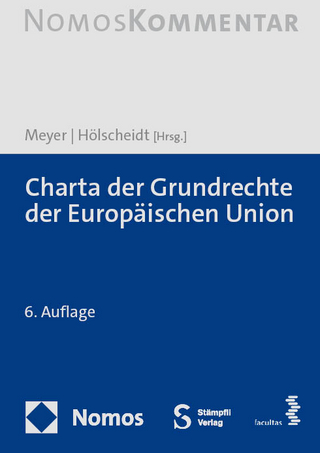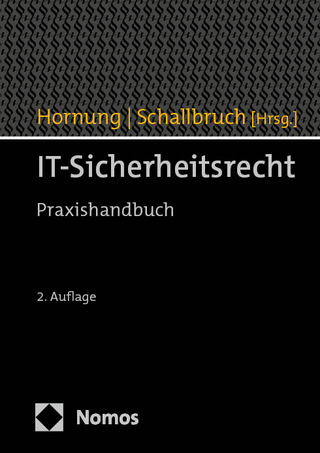
Rights of Individuals in an Earth Observation and Satellite Navigation Environment
Martinus Nijhoff (Verlag)
978-90-04-68537-6 (ISBN)
New Space technologies, Earth observation and satellite navigation in particular, have proven to be invaluable drivers of sustainable development, thus contributing to the protection of several human rights (the “Good”).
At the same time, however, New Space technologies raise concerns for the right to privacy (the “Bad”), and face a number of challenges posed by hostile cyber operations (the “Ugly”).
Dr. Arianna Vettorel analyzes the relevant international, European and domestic legal frameworks and highlights the need for several innovative approaches and reforms, in a transnational and bottom-up perspective, in order to maximize the Good, and minimize the Bad and the Ugly, of New Space technologies.
Arianna Vettorel, Ph.D., is Lecturer of International and EU Law at Ca' Foscari University of Venice (Italy), where, in 2023, she taught the innovative course "The Law of the New Space Economy". She has published essays in the field of space law as well as in international, EU and human rights law-related matters. Dr. Vettorel is Attorney at Law and has also served as arbitrator in commercial law disputes.
Preface and Acknowledgments
Abbreviations
Table of Cases
Table of International Universal Treaties and UN Resolutions
Table of International Regional Treaties and Legislation
Table of Domestic Legislations
Introduction
Part 1
The Good: the Role of New Space Earth Observation and Satellite Navigation Activities for Security and Sustainability
1 From Outer Space to New Space’s Benefits for Humankind
1 Outer Space, Global Commons and Common Heritage of All Humankind: Preliminary Remarks
1.1 Global Commons: an Overview
1.2 The Common Heritage of Humankind: an Overview
1.3 The Traditional Governance of Outer Space: a Global Commons or a Common Heritage of All Humankind?
2 The Emergence of New Space
2.1 From State to Private Sector Space Activities
2.2 The Example of the Italian Space Industry
3 New Space Activities: the Good, and Related Concerns
3.1 General Considerations
3.2 New Space Earth Observation and Satellite Navigation Possibilities (Security and Sustainability) and Related Concerns
4 Final Remarks
2 Earth Observation, Satellite Navigation and Human Rights: the EU and Italian Contributions to the UN Agenda 2030
1 Earth Observation and Satellite Navigation: a Preliminary Overview
1.1 Remote Sensing and Earth Observation Satellites
1.2 Satellite Navigation Systems
2 The Impact of Earth Observation and Satellite Navigation Activities on the UN Agenda 2030 and on Human Rights
3 The Contribution of the European Union and of the European Space Agency Space Activities to the Sustainable Development Goals
3.1 EU Eyes on Earth: the EU Copernicus Program
3.2 The EU Satellite Navigation Program: Galileo
3.3 EU Eyes on Outer Space: the EU Surveillance Program
4 The Contribution of the Italian Space Industry to the Sustainable Development Goals
5 Final Remarks
Part 2
The Bad: Potential Threats to Privacy from New Space Earth Observation and Satellite Navigation Activities
3 Earth Observation, Satellite Navigation and Privacy: the International, European and Italian Legal Framework
1 Monitoring and Threats to Privacy
2 Privacy and Space Law: the 1986 United Nations Principles Relating to Remote Sensing of the Earth from Outer Space
3 Privacy as a Universally-Recognised Human Right
3.1 The Universal Declaration of Human Rights, the UN Covenant on Civil and Political Rights, and the UN ‘Privacy Discourse’: Overview
3.2 Potential Application of the Universal Declaration of Human Rights, the UN Covenant on Civil and Political Rights, and the UN ‘Privacy Discourse’ to Outer Space Activities
3.3 Legal (Lack) of Effectiveness of the Universal Declaration of Human Rights, the UN Covenant on Civil and Political Rights, and the UN ‘Privacy Discourse’
4 Privacy Protection in Regional Legal Systems: the Case of Europe
4.1 The Human Right to Privacy and the Protection of Personal Data
4.2 Privacy Protection within the Council of Europe
4.3 The Protection of Privacy in the European Union
5 Privacy and Personal Data Protection in Italy
6 Final Remarks
4 The Use of Satellite Data in International and European Regional Courts: the Case-Law of the European Court of Human Rights and the European Court of Justice
1 Judicial Balancing of Security and Privacy: the Case of Satellite Data in Judicial Proceedings
2 The Use of Earth Observation Images as Evidence in International Courts: the International Court of Justice, the International Criminal Tribunal for the Former Yugoslavia, and the International Criminal Court
3 The Use of Earth Observation Images as Evidence in European Regional Courts
3.1 The European Court of Human Rights
3.2 The European Court of Justice
4 The Use of Satellite Navigation Data as Evidence in International Judicial Proceedings
5 The Use of Satellite Navigation Data as Evidence before the European Court of Human Rights and the European Court of Justice: Privacy Issues and the Critical Role Played by the Proportionality Test
5.1 The Proportionality Test: Overview
5.2 The Legal Framework of Proportionality within the European Convention on Human Rights
5.3 The Legal Framework of Proportionality within the European Union
6 The Admissibility of Satellite Navigation Data as Evidence in Proceedings before the European Court of Human Rights
6.1 Targeted Surveillance and Satellite Location Data
6.2 Bulk Surveillance: the Relevance of Geo-Location on Privacy
7 The Admissibility of Satellite Navigation Data as Evidence in Proceedings before the European Court of Justice
7.1 Targeted Surveillance and Satellite Location Data
7.2 Bulk Surveillances: the Relevance of Geo-Location on Privacy
8 Final Remarks
5 The Use of Satellite Data in Italian Courts
1 Preliminary Overview on Evidence in Italian Judicial Proceedings
2 Earth Observation Images as Evidence in Judicial Proceedings and Privacy
2.1 The Use of Earth Observation Images in Judicial Proceedings
2.2 Privacy Concerns Related to Earth Observation Images in Investigation Activities
3 Satellite Navigation Data as Evidence in Criminal Proceedings
3.1 Satellite Navigation Tracker Devices
3.2 Satellite Location Data Captured by Interceptions of Telematic Communications
3.3 Remote Searching of Computer Systems
3.4 Access to Communication Data Stored by Telecommunication Providers
3.5 Possible Different Classifications of Satellite Geo-Tracking and Their Related Impact on the Need for Prior Authorisation as a Privacy Guarantee
4 Satellite Navigation Data as Evidence in Civil Judicial Proceedings: Labour Disputes
4.1 The Legal Framework: Privacy Guarantees Provided in Article 4 of the Italian Labour Act
4.2 The Non-application of Privacy Guarantees Enshrined in Article 4 of the Italian Labour Act in Relation to the Monitoring of Potential Employee Torts
4.3 The Rise of the Privacy Discourse in Satellite Monitoring of Potential Employee Torts
5 Final Remarks
Part 3
The Ugly: Hostile Cyber Operations in New Space and Their Impact on Public Interests and Human Rights
6 Cyber Operations in New Space: Responsibility and Liability Issues
1 Cyber Operations towards New Space-Related Activities: Preliminary Remarks
1.1 Cyber Operations: Definitional Issues
1.2 The Impact of Cyber Operations on New Space-Related Activities, Particularly on Earth Observation and Satellite Navigation
2 Responsibility and Liability Issues in New Space
2.1 The Concepts of Responsibility and Liability: Overview
2.2 The Law Applicable to Responsibility and Liability in an International and Transnational Perspective
3 Definitional Issues in the New Space Era
4 State International Responsibility and Liability for Cyber Operations towards New Space Facilities and Activities Prior to the (Attempted) Launch of Space Objects
4.1 General International Law Provisions: Overview
4.2 ‘On-Earth Cyber Operations’ before the (Attempted) Launch and Issues Related to the Application of General International Law Rules on State Responsibility
4.3 Cyber Operations and the Emerging Approaches of the European Union and Italy
5 State Responsibility for Cyber Operations Perpetrated in Outer Space, and Liability for Damages Caused by Cyber Operations after the (Attempted) Launch of Space Objects
5.1 The Outer Space Treaty and the Liability Convention: Overview
5.2 Interpretative Issues and Concerns Related to the Regulation of Responsibility and Liability for Cyber Operations in Outer Space or after the (Attempted) Launch of a Space Object
5.3 National Implementation: the (Bad) Example of Italy
6 Responsibility of International Organisations for New Space Cyber Operations
7 Responsibility and Liability of Individuals and Private Entities for New Space Cyber Operations
7.1 Individual Criminal Responsibility for New Space Cyber Operations Occurring on Earth or in Outer Space before or after the Attempt to Launch a Space Object
7.2 Private Civil Obligations to Compensate Damages Deriving from New Space Cyber Operations before the Attempt to Launch a Space Object
8 The Need for Specific Cybersecurity International Provisions Applicable to New Space Activities: the Missed Opportunity of the Tallinn Manuals
9 Final Remarks
7 Cybersecurity in New Space: Soft Law and Transnational Private Regulation
1 (Lack of a Universal) Cybersecurity Definition
2 (Lack of a Universal) Cybersecurity Regulation
3 International Soft Law Initiatives and Cybersecurity
3.1 Soft Law: Definition and Debated Issues
3.2 International Soft Law Initiatives to Enhance Cybersecurity
4 Transnational Private Regulation and Cybersecurity
4.1 Transnational Private Regulation: Definition and Debated Issues
4.2 Examples of Transnational Private Initiatives to Enhance Cybersecurity
5 Cybersecurity in New Space
6 Final Remarks
Conclusions
1 The Good: Outer Space and New Space Relevance for Security, Sustainable Development and Human Rights: the Case of Earth Observation and Satellite Navigation Technologies
1.1 The Contribution to the UN Agenda 2030
1.2 Outer Space and New Space Relevance for Security, Sustainability and Human Rights: Effects in Terms of Legal Qualification and Governance
2 The Bad: the Human Right to Privacy under Threat
2.1 New Space Privacy Risks and the International Universal Legal Framework: the Need to Revise the Existing Regulation
2.2 The Protection of Privacy by European Regional Systems: the Need to Implement Hermeneutical Approaches or to Implement Existing Legal Rules
3 The Ugly: Hostile Cyber Operations in New Space as a Risk for Privacy and Public Interests
3.1 Issues Related to Post Factum Reactions
3.2 The Need for Preventive Actions
4 Soft Law and Transnational Private Regulation: a Remaining Necessity for Hard Law?
Bibliography
Index
| Erscheinungsdatum | 07.11.2023 |
|---|---|
| Reihe/Serie | Studies in Space Law ; 22 |
| Sprache | englisch |
| Maße | 155 x 235 mm |
| Gewicht | 1 g |
| Themenwelt | Recht / Steuern ► EU / Internationales Recht |
| Recht / Steuern ► Öffentliches Recht ► Völkerrecht | |
| ISBN-10 | 90-04-68537-5 / 9004685375 |
| ISBN-13 | 978-90-04-68537-6 / 9789004685376 |
| Zustand | Neuware |
| Haben Sie eine Frage zum Produkt? |
aus dem Bereich


